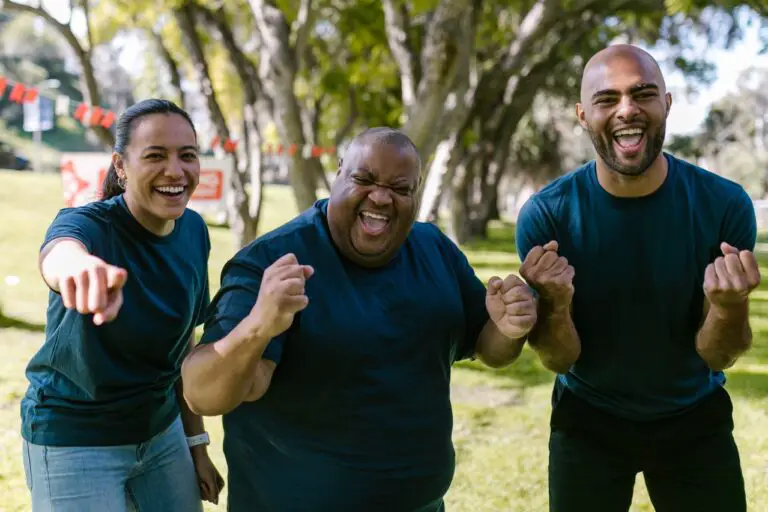We all have bodies. And we’re literally quite attached to them. That’s why health and the body is a universal topic in EFL/ESL, from young children right up to advanced adults.

But let’s not settle for boring worksheets and uninteresting tasks. Let’s make our classes memorable. Fortunately, I’ve got five activities for doing exactly that!
Not all five will suit your class exactly. You may have to adjust them to suit the level and preferences of your students, and in some cases, don’t do the activity at all. But with a little tweaking, there’s no reason why you can’t use most of them in any of your lessons.
So let’s get to it!
- Label the body parts
- Medical interviews
- Simon Says / Simone Says
- Health-themed role-play scenarios
- Health awareness campaign (project)
1. Label the body parts
This is a fun elicitation activity which challenges students to think of vocab they’ve previously learned.
It consists of labelling body parts on a model, and what model you use depends on the nature of your group of students.

With kids, a recognisable character from a film or TV series is a good bet. Someone who is a human (although certain monsters can be fun!) and has enough distinguishable features to be labelled.
Peppa Pig is a bad choice. The cartoony nature and lack of distinguishable human features means there’s not much to label. A full-body picture of Captain America, on the other hand, is a great option.
With older students, you can stick with fictional characters, or go for famous people. You can often get good pictures of athletes and singers.
A potential alternative is to have students write on each other. This absolutely requires a level of trust and maturity, as well as some pens that are safe to use on skin and wash off easily. But what better way for a student to remember the word for “wrist” than by writing on their own?
2. Medical Interviews
Practicing making questions and gaining confidence in speaking are the goals of this activity.
Get students to imagine they are doctors doing a medical history check on their patients. They should come up with some questions to ask. For example:
- Have you ever broken a bone?
- What illnesses did you have as a child?
- Do you have any allergies?
When they have 3-4 questions, they can ask them to others by mingling around the classroom. If you have an individual or very small group, get them to write a few more questions.
They pair up to ask and answer their questions, then move on, until they’ve spoken to everyone.

I’d avoid making them write down the answers, as this takes up a lot of time. However, if you want to turn it into a survey, you could do so. Get them to ask some specific questions that have yes/no or closed answers.
For example, one student could make a survey about how many students in the class have broken a bone in their body. Extend this by finding out how many broke their arm, finger, leg, toe, etc.
Meanwhile, another student could go around finding out the most common allergies and having some statistics at the end.
3. Simon Says / Simone Says
I think every EFL/ESL teacher knows the game Simon Says (although it has different names in some regions). It’s super simple, but adapted to learn body parts, it’s powerful.
As a teacher, you start by giving the commands, but I recommend letting students take turns being Simon. This means they can practice a little speaking as well as listening.
Simple commands like “touch your nose” are fine for beginners and kids, but increase the difficulty with things like “put your elbow on your knee” or “touch your chin to your chest”.
And for students who might find the game a little childish, play Simone Says. This is “hard mode” and incorporates a lot more mental challenge. Incorporate right and left, interacting with other people, and complex moves. Here’s a video for some inspiration:
4. Health-themed role-play scenarios
Role plays are fantastic. With the right set up and expectations, they can be transformative for students developing their fluency. And they’re a great way of practicing specific language around health problems.
I’d avoid using role plays with absolute beginners and kids under 8, as the maturity level and language requirements are too high.
In a role play, there is no script. Students put themselves in the shoes of someone in a particular scenario and improvise the events, with the focus on communication using English.
To learn more about how to use role play in your class, and why I love it so much, check out this article: Why All EFL/ESL Teachers Should Use Role Play Activities.
They work best with pairs, although you can put students in a three if you have an odd number. Here’s a scenario you can use right now!
In pairs, just assign the roles A and B. For groups of three, add in role C as a supplementary character.
| STUDENT | ROLE |
|---|---|
| A | You have a very strange illness. You go to see the doctor (Student B) to ask what is wrong with you. |
| B | You are a doctor. Student A has a strange illness. Ask them questions and do tests to see what the problem is. |
| C (optional) | You are the doctor’s assistant and you help them (Student B) to find out what is wrong with Student A. |
This scenario is quite open-ended. I recommend getting students to think of possible symptoms beforehand so they don’t have to improvise them on the spot. Also, the illnesses don’t have to be medically accurate. Kids will likely invent some wild new diseases!
5. Health awareness campaign (project)
This is a longer project-style activity that gets students developing a range of skills. The final product is up to you, so adjust it as you see fit.
Individuals or small groups work together to inform the public about some aspect of health. With kids and lower-level students, this may be very simple, like healthy eating or brushing teeth. For more advanced and mature groups, it could be about smoking or muscle conditioning.

Give the students some structure, by dividing it into four phases.
- Ideas: Think about the aspect of health to target and how they’re going to inform the public.
- Research: Gather information about the topic and find useful English phrases and vocabulary.
- Production: Create the “product” of the project.
- Present/distribute: Get the information out in the world.
Some good ideas of things to make are:
- Podcasts
- Posters to put on walls
- Interactive presentations
- Online posts on a blog or social media
- Public service videos
The extent and the scale of the project is up to you. Limiting it to presentation in the classroom is fine, but it would be more motivating to get students to create a poster that you could stick up around the school, or a clip to share with their friends and family online.
Conclusion
These 5 activities are by no means the only ones you can do in your classroom. And you don’t have to do them exactly as I’ve written. Adapt and evolve them to suit your needs.
I have more resources about teaching health and the body in EFL/ESL, including a full lesson plan and more role-play scenarios. You can get them by signing up to my free monthly newsletter. You’ll also get access to all the other guides, lesson plans and materials exclusive to subscribers.







